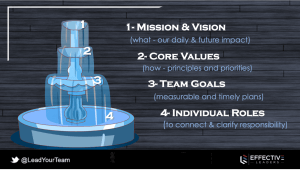How a Team Alignment Fountain Helps Effective Leaders Build Culture and Boost Productivity

Sean Glaze is an author and leadership expert who has worked with clients like the CDC, John Deere, and Emory University to increase collaboration, boost performance, and build exceptional workplace cultures. Sean’s engaging conference keynotes and interactive team building events help you develop more effective leaders. As a successful coach and educator for over 20 years, Sean gained valuable insights into developing winning team cultures – and founded Great Results Team Building to share those lessons.
Leaders understand that team alignment plays a pivotal role in the productivity of their organization.
When team members are aligned in their understanding of the mission, vision, values, goals, and roles, productivity soars, collaboration flourishes, and outcomes improve.
Alignment ensures that everyone is moving in the same direction, working towards shared objectives, and fostering a high-performing culture. Alignment is vital for teams to improve productivity and to build and sustain a positive and profitable workplace culture.
So, How Does Team Alignment Improve Productivity?
Alignment provides teams with a clear sense of direction and purpose. When team members are aligned in their understanding of the mission, vision, values, goals, and roles, it creates a cohesive framework that guides their actions and decision-making.
A clear direction allows team members to prioritize their efforts, stay focused on key objectives, and minimize distractions. According to a study by Harvard Business Review, aligned teams are 23% more likely to achieve their goals.
Alignment fosters collaboration by establishing common goals, values, and expectations. When team members are aligned, they can communicate more effectively, share resources, and leverage each other’s strengths.
Aligned teams are more likely to collaborate proactively, generate innovative ideas, and support one another in achieving shared objectives. Forbes reports that 86% of employees and executives believe that lack of collaboration and ineffective communication are responsible for workplace failures.
Alignment drives improved performance and results, also.
When team members are aligned, they work cohesively towards a shared vision, leveraging their collective efforts to achieve desired outcomes. Alignment enables teams to streamline processes, avoid duplications, and make decisions that align with organizational goals. A study by Gallup found that organizations with high levels of alignment achieve 21% higher profitability.


Embracing alignment as a leadership priority will drive productivity, engagement, and long-term success.
Okay – So HOW Do We Improve Team Alignment?
Define and Communicate the Mission and Vision
A well-communicated mission, vision, and set of values provide a solid foundation for alignment. Having a clear mission defines the team’s purpose, and the vision outlines the desired future state. Communicate these elements to the team regularly, ensuring that everyone understands and embraces them. Encourage team members to align a compelling passionate purpose and you will see engagement increase.
Define Your Core Values
Your organizational values establish the guiding principles for decision-making and behavior. While mission and vision create a destination, your values clarify the priorities that will determine how you get there – they are the beliefs that will drive the behaviors that your team sets as a standard – and they must be defined by examples. Defining values as behaviors will help your people understand what each value looks like in your hallways and interactions.
Set Team Goals
Setting Specific, Measurable, Achievable, Relevant, and Time-bound (SMART) goals is crucial for alignment. Collaboratively set goals that align with the team’s mission and vision, ensuring they are clear, realistic, and measurable. Establish accountability by assigning responsibilities and deadlines to individual team members. Regularly track progress, provide feedback, and celebrate achievements to maintain alignment and motivate the team.
Clarify Roles and Responsibilities
Defining roles and responsibilities is essential to avoid confusion, conflicts, and duplication of efforts. Clearly articulate each team member’s role, outlining their specific responsibilities, and decision-making authority. Like good business team building events, role clarity inspires more team collaboration. Ensure that roles are aligned with individual strengths and expertise, creating a sense of ownership and empowerment. Regularly revisit and update roles as the team evolves and new challenges arise.
Organizational alignment positively impacts leadership effectiveness and contributes to the development of a high-performing team culture.
When team members share a common understanding of the mission, vision, values, goals, and roles, they are more likely to collaborate, support one another, and strive for excellence. A report by Gallup highlighted that organizations with high levels of employee engagement, a key indicator of a high-performing culture, have clear expectations and align individual goals with the overall mission.
Alignment is the cornerstone of team productivity and success. When team members are aligned in their understanding of the mission, vision, values, goals, and roles, they work cohesively, collaborate effectively, and achieve exceptional results.
By defining and communicating the mission, vision, and values, setting SMART goals, fostering accountability, and clarifying roles and responsibilities, leaders can increase alignment and create a high-performing culture.
Embracing alignment as a leadership priority will drive productivity, engagement, and long-term success.

Want new articles before they get published? Subscribe to our Awesome Newsletter.

CAREER ADVICE

GOV TALK

TRENDS




